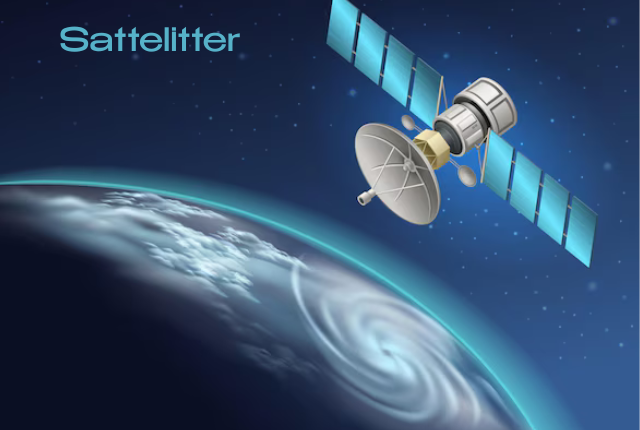Introduction to Satellites
Have you ever looked up at the night sky and marveled at the stars? Among them are countless satellites, silently orbiting our planet. These incredible machines play a pivotal role in modern life, from how we communicate to how we navigate. Satellites have evolved far beyond their original purpose, becoming essential tools for various industries and everyday tasks.
Curious about what makes these technological marvels so fascinating? Let’s dive into the world of sattelitter and explore their types, functions, evolution, impact on society, and what lies ahead for satellite technology. Whether you’re a tech enthusiast or just someone who enjoys gazing at the stars, there’s something here for everyone!
Types of Satellites and their Functions
Satellites come in various types, each serving distinct functions. Communication satellites play a crucial role in transmitting signals for television, internet, and phone services. These orbiting marvels keep us connected across vast distances.
Earth observation satellites provide invaluable data about our planet. They monitor climate changes, track natural disasters, and assist in agricultural planning by offering real-time imagery of crops.
Navigation satellites like those in the Global Positioning System (GPS) guide us on land and sea. They help with navigation by providing accurate location data for personal devices and vehicles.
Scientific satellites explore outer space or observe astronomical phenomena. Equipped with advanced instruments, they gather vital information that enhances our understanding of the universe.
Military satellites support national security operations. They conduct surveillance and reconnaissance missions to ensure safety from potential threats while maintaining strategic advantages globally. Each type plays a significant role in advancing technology and society’s needs.
The Evolution of Satellite Technology
The journey of satellite technology began in the mid-20th century. The launch of Sputnik 1 by the Soviet Union in 1957 marked a pivotal moment. It was humanity’s first artificial satellite, orbiting Earth and sending signals back home.
Since then, advancements have skyrocketed. Early satellites were bulky and rudimentary, serving mainly for communication and weather tracking. Today’s satellites are sleek marvels equipped with advanced sensors and high-resolution cameras.
The introduction of miniaturization has transformed design standards. Smaller satellites can now perform complex tasks at lower costs. This evolution has opened doors for startups to enter space exploration.
Moreover, innovations such as CubeSats enable universities and research institutions to contribute valuable data without enormous budgets. Each leap forward enhances global connectivity, environmental monitoring, and disaster response capabilities while shaping our understanding of space like never before.
Advantages and Disadvantages of Satellites
Satellites offer numerous advantages that greatly benefit modern society. They provide essential services such as global communication, weather forecasting, and navigation. With satellites in orbit, we can connect with anyone around the world instantly.
Moreover, satellite imagery aids in disaster management and environmental monitoring. This technology helps track climate change and natural disasters effectively.
However, satellites come with drawbacks too. The initial costs of launching and maintaining them are significant investments for any country or organization. There is also the risk of space debris accumulating over time, which poses threats to operational satellites.
Privacy concerns arise from surveillance satellites that monitor activities on Earth without consent. Additionally, satellite signals can be disrupted by atmospheric conditions or physical obstructions like tall buildings.
Understanding both sides allows us to appreciate the role of sattelitter while recognizing their limitations in our lives.
The Impact of Satellites on Society
Satellites have transformed our daily lives in profound ways. They play a crucial role in communication, enabling instant connections across the globe. From video calls to social media updates, satellites make it all possible.
In addition to connectivity, they contribute significantly to weather forecasting. Accurate predictions help us prepare for natural disasters and mitigate their impact.
Moreover, satellites enhance global navigation systems. GPS has revolutionized travel and logistics by providing precise location data.
The agricultural sector also benefits from satellite technology. Farmers can monitor crops more effectively and optimize resource use through satellite imagery.
However, it’s not just about convenience; satellites are vital for scientific research too. They provide valuable data for climate studies and environmental monitoring.
As society continues to evolve with technology, the influence of satellites will only grow stronger across various domains.
Future of Satellite Technology
The future of satellite technology is poised for remarkable advancements. With the rise of mega-constellations, like those being developed by SpaceX and OneWeb, global internet coverage will become more accessible than ever.
Miniaturization is another trend to watch. Smaller satellites are not only cost-effective but also easier to launch in groups, allowing for rapid deployment and enhanced capabilities.
Artificial intelligence will play a crucial role as well. AI can optimize data processing from satellites, enabling quicker decision-making for applications like disaster response or environmental monitoring.
Moreover, inter-satellite communication systems promise faster data transfer rates. This innovation could reshape industries relying on real-time information.
As we venture into new frontiers such as lunar exploration and Mars missions, satellites will be essential tools in our quest to understand the cosmos better. The possibilities seem endless as technology continues to evolve at breakneck speed.
Conclusion
Satellites, or sattelitter as they are known in some regions, have become an integral part of our daily lives. They play a crucial role in communication, navigation, weather forecasting, and even scientific research. The evolution of satellite technology has pushed the boundaries of what we can achieve from space.
With their various types serving distinct functions—from geostationary satellites providing constant coverage to low Earth orbit satellites enabling global internet connectivity—their impact is undeniable. While there are advantages such as enhanced communication and improved data collection, challenges like space debris and high costs remain significant concerns.
As we look toward the future of satellite technology, advancements will continue to shape industries and improve everyday life. Innovations on the horizon promise to make satellites more efficient and accessible than ever before. The journey of these remarkable machines continues to unfold with endless possibilities for exploration and discovery through advancements yet unseen.


